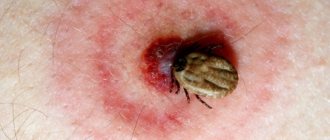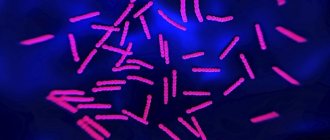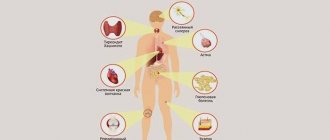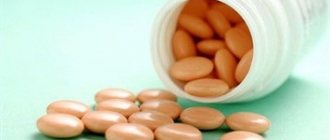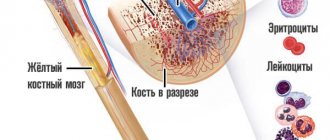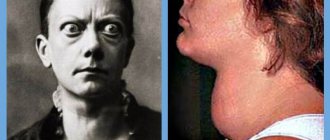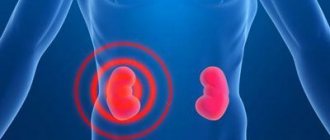Author: Soldatenkov Ilya Vitalievich, general practitioner
Dyslipidemia is a pathological condition caused by impaired fat metabolism in the body and leading to the development of atherosclerosis . The vascular walls become denser, the lumen of the vessels narrows, blood circulation in the internal organs is disrupted, which ends in ischemia of the heart muscle or brain, hypertension, stroke or heart attack.
Abnormally elevated levels of lipids in the blood are called hyperlipidemia or hyperlipoproteinemia. This condition is a direct consequence of a person's lifestyle. The appearance of hyperlipidemia depends on the patient’s diet, medications he takes, physical activity and bad habits.
Dyslipidemia is a laboratory indicator indicating an imbalance of fatty substances in the human body, which are low-molecular compounds synthesized in the liver and transported to cells and tissues using lipoproteins - complex lipid-protein complexes.
There are 3 types of lipoproteins: high, low and very low density (HDL, LDL, VLDL).
LDL and VLDL are unreliable transporters. Their molecules are quite large and prone to cholesterol precipitation. They cause heart and vascular diseases, and their cholesterol is considered “bad”. During transportation, LDL often loses cholesterol or penetrates into the walls of blood vessels along with it, forming cholesterol plaques on the endothelium, which reduce the lumen of blood vessels. Fat deposits caused by dyslipidemic disorders impede systemic blood flow and provoke hemodynamic damage to organs and tissues.
HDL is not atherogenic, dissolves well in water and removes cholesterol from blood vessels. In the liver, it is transformed into bile acids, which leave the human body through the intestines.
The affected vessels narrow, little oxygen reaches the tissues, and hypoxia and ischemia develop. These processes underlie the development of life-threatening pathologies - angina pectoris, myocardial infarction, hypertension, stroke.
Active biosynthesis of fats in the body, impaired excretion and their abundant intake from food lead to hyperlipidemia, which does not manifest itself with specific symptoms, but provokes the formation of various diseases.
Degrees
According to the mechanism of occurrence of dyslipidemia, the following degrees are distinguished:
- Primary. In this case, the disease is not a consequence of any pathologies.
- The secondary degree of dyslipidemia implies the development of pathology due to certain diseases.
- Nutritional. It develops against the background of excessive consumption of animal fats.
Depending on the lipids whose levels are elevated, the following forms are distinguished:
- Pure hypercholesterolemia. Against this background, there is an increase in cholesterol in the composition of lipoproteins.
- Mixed hyperlipidemia. At the same time, an increase in cholesterol and triglycerides is observed in the blood.
Prevention measures
Secondary and nutritional dyslipidemia syndrome can be prevented by changing lifestyle, treating or prolonging the remission of underlying chronic diseases. Otherwise, no doctor will take responsibility for the complications and consequences that develop.
So what’s better: pull yourself together or save yourself in a cardiology clinic from a heart attack or a neurological center from a stroke? In response, you can paraphrase the famous catchphrase: saving a patient is the work of the patient himself (and a little of the doctor).
ICD-10 Category: E78.2
Fredrickson classification of dyslipidemia
The Fredrickson classification involves determining the type of disease depending on the type of elevated lipid:
- The first type involves hereditary hyperchylomicronemia. In this case, only large lipoproteins will be elevated in the blood. It must be said that this is the only type of dyslipidemia whose ability to cause atherosclerosis has not yet been proven.
- Type “2a” is hypercholesterolemia caused by hereditary factors, and also by the influence of the external environment. Against the background of this type, a person’s blood has increased levels of lipoproteins that have a low density.
- Type "2b" is combined hyperlipidemia. Against this background, low-density lipoproteins and triglycerides increase in the blood. This classification of dyslipidemias is very popular.
- The third type is characterized by hereditary lipoproteinemia. At the same time, low-density lipoproteins increase in the blood.
- The fourth type involves endogenous hyperlipidemia, when extremely low-density lipoproteins increase in the blood.
- The fifth type is characterized by hereditary hypertriglyceridemia, when extremely low-density lipoproteins along with chylomicrons increase in the blood.
You will be interested in: “Dexalgin”: analogues, instructions for use, reviews
Next, we will find out what reasons can influence the development of such a phenomenon as dyslipidemia.
What this is, we explained above.
Types of fat metabolism disorders
What is dyslipidemia? It is a symptom of specific diseases, as well as a consequence of poor nutrition and bad habits. Accordingly, there are many types of fat metabolism disorders. The need to classify and organize them arose quite quickly.
In the international classification of diseases (ICD-10), dyslipidemias are allocated a separate group - E78. This includes all independent pathologies associated with an increase (hyperlipidemia) or decrease (hypolidemia) in fat levels.
By origin, dyslipidemia can be:
- primary (congenital) – caused by gene defects;
- secondary (acquired) – caused by diseases of internal organs, bad habits, and poor diet.
Some experts separately distinguish nutritional dyslipidemia - a disorder of fat metabolism caused by poor diet.
In clinical practice, the division of pathologies proposed by the American Donald Fredrickson is most often used. He divided all hyperlipidemias into 6 groups, using the type of lipids with altered concentrations as the basis for the classification. It was later approved by WHO as the standard nomenclature for disorders associated with increased fat levels.
Fredrickson classification of hyperlipidemia.
| Type | Type of violation | Name of birth defect | Treatment |
| I | Total cholesterol: elevated or normal | Hereditary hyperchylomicronemia | Diet |
| LDL: elevated or normal | |||
| Triglycerides: very elevated | |||
| Chylomicrons: increased | |||
| IIa | Total cholesterol: elevated or normal | Polygenic hypercholesterolemia, hereditary hypercholesterolemia | Statins, vitamin B3 |
| LDL: elevated | |||
| Triglycerides: normal | |||
| IIb | Total cholesterol: elevated or normal | Hereditary mixed hypercholesterolemia | Statins, fibrates, vitamin B3 |
| LDL: elevated | |||
| VLDL: increased | |||
| Triglycerides: elevated | |||
| III | Total cholesterol: elevated | Hereditary dys-beta lipoproteinemia | Fibrates |
| LDL: low or normal | |||
| DILI: increased | |||
| Triglycerides: elevated | |||
| Chylomicrons: many residual particles | |||
| IV | Total cholesterol: elevated or normal | Endogenous hyperlipemia | Vitamin B3 |
| LDL: normal | |||
| VLDL: increased | |||
| Triglycerides: elevated | |||
| V | Total cholesterol: elevated | Hereditary hypertriglyceridemia | Vitamin B3, fibrates |
| LDL: normal | |||
| VLDL: increased | |||
| Triglycerides: very elevated | |||
| Chylomicrons: increased |
Hereditary hypolipidemias include 4 pathologies:
- abetalipoproteinemia (Bassen-Kornzweig syndrome) – absence of VLDL, LDL, chylomicrons in the blood;
- hypobetalipoproteinemia – insufficient LDL content;
- chylomicron retention disease, manifested by the lack of synthesis of these structures;
- hypoalphalipoproteinemia (Tangier Islands disease) – absence of HDL in the blood plasma.
Causes of pathology
There are many reasons for the development of this disease. So, the following are distinguished:
- Receiving a pathology by inheritance from one or both parents. In this case, an abnormal gene responsible for cholesterol synthesis is transmitted to a person.
- The presence of hypothyroidism, that is, decreased thyroid function due to its inflammation or surgical removal.
- The development of diabetes mellitus, against the background of which the supply of glucose is disrupted.
- Obstructive liver diseases, in which there is a violation of the outflow of fluid secreted by this organ. For example, this happens with gallstone disease.
- Treatment with drugs. For example, some diuretic drugs, beta blockers, immunosuppressants and the like can trigger this disease.
- Increased content of animal fats in daily food, that is, abuse of cholesterol-rich foods.
- Physical inactivity, that is, a sedentary lifestyle.
- Stressful type of character, when a person has violent emotional reactions to various stimuli.
- Alcohol abuse, smoking.
- The presence of arterial hypertension, against the background of which a person experiences a persistent increase in blood pressure.
- Presence of abdominal obesity.
We continue to understand what dyslipidemia is and how to treat this disease.
What are lipids, lipoproteins and hyperlipidemia?
There is an opinion that fats are harmful to the body. It's not like that at all. Fats are the most important component of all living organisms, without which life is impossible. They are the main “energy station”; through chemical reactions they produce the energy necessary for metabolism and cell renewal.
Fats become harmful when their content is excessive, especially certain types that lead to atherosclerosis and other diseases - low-density lipids, or atherogenic ones. All fatty substances in the body are divided into 2 groups according to their chemical composition:
Lipids
The name comes from the Greek lipos - fat. This is a whole group of fat-forming substances in the body, including:
- fatty acids (saturated, monounsaturated, polyunsaturated);
- triglycerides;
- phospholipids;
- cholesterol.
The fatty acids that everyone knows about and which play a big role in the development of atherosclerosis are saturated ones. They are found in animal products. Unsaturated acids, on the contrary, prevent the development of atherosclerosis; they are found in vegetable oils and seafood (omega 3, omega 6, omega 9 and others).
Triglycerides are neutral fats, derivatives of glycerol, which are the main suppliers of energy. Their increased content contributes to the development of diseases. Phospholipids contain a phosphoric acid residue and are necessary for the maintenance of nervous tissue.
Finally, everyone knows cholesterol - the main culprit of many diseases, and the most common “disease of the century” - atherosclerosis. It comes in two types: high density, or “good cholesterol,” and low density, or “bad cholesterol.” It is this substance that is deposited in organs, causing fatty degeneration, in blood vessels, causing circulatory problems.
The problem of high cholesterol has become especially acute in the last few decades. Cholesterol is considered high when its norm is exceeded by a third. At the same time, the real threat to the human body is a certain type of cholesterol - low-density lipoproteins. Accumulating on the walls of the vascular system, LDL clogs the vessels.
Lipoproteins
These are more complex compounds, including lipids and protein molecules. They are divided into:
- chylomicrons, which perform a transport function, deliver fat from the intestines to tissues and organs, including promoting its deposition in the subcutaneous tissue;
- lipoproteins of various densities - high (HDL), low (LDL), intermediate (LDL) and very low (LDL).
Lipoproteins and low-density lipids, chylomicrons contribute to the accumulation of fatty substances and “bad” cholesterol in the body, that is, the development of hyperlipidemia, against which diseases develop.
The normal content of major fatty substances in the blood is presented in the table:
Name of substance
Normal indicator
Low-density lipoproteins (LDL)
1.92 - 4.82 mmol/l
High density lipoproteins (HDL)
Diagnostics
Carrying out diagnostics in this case involves various studies, including:
- Analysis of patient complaints.
- Collecting a life history, during which the attending physician finds out what the patient’s illness was, what his profession is, and whether he has any infectious diseases. For example, a history may indicate vascular atherosclerosis or myocardial infarction. In addition, information about familial dyslipidemia can be obtained.
- Conducting a physical examination. In this case, xanthelasmas may be observed along with the lipoid arch of the cornea. Dyslipidemia, as a rule, is not accompanied by changes in percussion and auscultation of the heart. And the pressure may most likely be increased.
- Conducting blood and urine tests. These studies are carried out to identify inflammatory processes and concomitant diseases. What else is involved in the diagnosis of dyslipidemia?
- Performing a biochemical blood test. At the same time, blood sugar and protein levels are determined. Creatinine and uric acid are also being studied. Such studies are important to identify concomitant organ damage.
- Performing a lipid profile. This analysis is the main method for diagnosing pathology. As part of its implementation, triglycerides are studied primarily. Their high levels are observed in patients with diabetes. A parameter such as lipoproteins is also assessed. In addition, the atherogenicity coefficient is studied. If the atherogenicity coefficient exceeds “3,” this indicates a high risk of atherosclerosis.
- Performing an immunological blood test. As part of this study, specialists determine the level of antibodies to cytomegalovirus and chlamydia, and also examine the level of reactive protein, which is a protein whose value in the blood increases against the background of any inflammation.
- Performing genetic analysis to identify genes that are responsible for the development of hereditary dyslipidemia in relatives of patients.
You may be interested in: Wen on the neck: causes, symptoms, treatment, how to get rid
Next, let's move on to the issue of therapy for this pathology, and also find out what non-drug treatment options are available.
What are the recommendations for dyslipidemia?
Symptoms of the disease
Most cases of hyperlipidemia, especially in the initial stages, are asymptomatic. This is explained by the peculiarities of the development of pathology. At first, the body is able to compensate for the increased fat content. Then comes the decompensation phase, when an imbalance of lipids provokes the onset of the development of systemic pathologies, which do not immediately manifest themselves clinically.
It can take years to go through all of these stages. Therefore, hyperlipidemia is often discovered accidentally during a routine examination or examination for another reason.
Signs of more severe disorders vary and depend on the nature of the disease. Hereditary forms can manifest themselves by the appearance of subcutaneous tumor-like formations (xanthoma) on various parts of the body, including the eyelids (xanthelasma), excess weight, and changes in the structure of the blood vessels of the eye. Symptoms of acquired hyperlipidemia are specific to each specific disease.
Non-drug treatment of pathology
As part of non-drug treatment, the following methods of treating dyslipidemia are provided:
- It is very important to normalize body weight.
- Physical activity must be dosed, and it must be carried out exclusively in conditions of sufficient oxygen flow. The exercise regimen should be selected taking into account the location and severity of atherosclerosis, as well as concomitant diseases.
- You need to follow a diet with limited intake of animal fat. Food should be enriched with vitamins and dietary fiber. In addition, the caloric content of food must correspond to the patient’s load. Avoiding fatty and fried foods is very important. It is better to replace meat with fish in your diet. Preference should be given to sea fish three times a week. As for vegetables and fruits rich in fiber and vitamins, they should form the basis of the diet.
- It is very important to limit your alcohol consumption. It can increase triglycerides, which cause the development of atherosclerosis, a chronic disease characterized by hardening of artery walls. Among other things, alcohol leads to weight gain and worsens gout, causing muscle damage in people who take statins (a category of drugs that affect the liver's ability to synthesize lipids).
- Non-drug treatment also requires quitting smoking. The fact is that this bad habit significantly increases the risk of heart and vascular diseases, especially heart attack and damage to the arteries of the extremities. Quitting this bad habit, on the contrary, is accompanied by an increase in anti-atherogenic components in the blood that prevent atherosclerotic damage to the body.
Recommendations for dyslipidemia must be strictly followed.
What are the dangers of dyslipidemia?
Increased lipid levels are one of the leading risk factors for the development of atherosclerosis, and when combined with a high concentration of triglycerides, pancreatitis. Therefore, people with hyperlipidemia have an increased chance of developing peripheral artery disease, coronary heart disease, brain disease, as well as their most severe complications: myocardial infarction, stroke, ischemic necrosis of the feet.
The likelihood of cholesterol plaques appearing on the walls of blood vessels varies with different types of dyslipidemia. A high risk of developing atherosclerosis in people with types IIa, IIb, III of hyperlipidemia, moderate in cases IV, V. Type I atherogenicity has not been proven.
Hypolilipidemia is dangerous due to a lack of nutrients, primarily fatty acids and fat-soluble vitamins. Hereditary forms of dyslipidemia are especially difficult. They can lead to serious disturbances in the child’s growth: retardation in physical and mental development, and the appearance of neurological symptoms.
Drug treatment
Drug treatment of this disease involves taking the following drugs:
- Treatment with statins. These medications reduce cholesterol synthesis by the liver. In addition, they reduce the intracellular content of bad cholesterol, increasing the destruction of lipids. Statins have an anti-inflammatory effect, preventing damage to new areas of blood vessels. Statins can prolong the life of patients by reducing the incidence of complications of atherosclerosis along with the severity of vascular damage. True, these drugs cause damage to the liver and muscles, and therefore, while taking statins, it is necessary to monitor the blood test for the presence of liver and muscle destruction products. Statins should never be used if you have active liver disease. Statins are also prohibited for use in children and should not be used by pregnant and lactating women.
- Treatment of dyslipidemia with intestinal cholesterol absorption inhibitors. In this case, we are talking about a group of drugs that prevent the absorption of cholesterol in the intestinal area. The effect of this category of drugs is limited, since cholesterol, which comes from food, makes up approximately one fifth of all this element in the body. Four-fifths of cholesterol is formed directly in the liver. Absorption inhibitors are prohibited for children.
- Treatment with bile acid sequestrants. This is a group of drugs that binds bile acids that contain cholesterol and removes them from the body. But these medications can cause constipation in people, along with bloating and loss of taste. True, these medications are approved for children, nursing and pregnant women.
- Treatment with fibrates. This group of drugs reduces triglyceride levels and increases lipoprotein levels. Fibrates can be used in combination with statins. However, the use of fibrates is not recommended for children and pregnant and lactating patients.
- Treatment with Omega-3. These are the so-called polyunsaturated fatty acids, which are a group of drugs that are obtained from fish muscles. Omega-3 is famous for its ability to lower triglyceride levels. Thanks to such drugs, the risk of heart rhythm disturbances is reduced and the life of patients after myocardial infarction is extended.
You may be interested in: Ataxia - what is it? Types, causes, diagnosis, symptoms and treatment of the disease
Literature
- E. S. Kiladze. Cardiology in daily practice, 2009
- Thordur Sturluson. Natural Herbs to Lower Cholesterol Naturally
- Working group of the European Society of Cardiology (ESC) and the European Atherosclerosis Society (EAS) on the treatment of dyslipidaemias. Recommendations of the European Society of Cardiology and the European Society of Atherosclerosis for the treatment of dyslipidemia, 2012
Irina Kostyleva
Higher medical education. Kirov State Medical Academy (KSMA). Local therapist. More about the author
All articles by the author
Application of extracorporeal treatment methods
Extracorporeal treatment methods are aimed at changing the composition and properties of blood using special devices. Such methods include immunosorption of lipoproteins along with cascade plasma filtration, plasma sorption, hemosorption and others. Such treatment methods are used to treat the most severe forms of dyslipidemia. These treatment options are allowed for children whose body weight is at least twenty kilograms.
What kind of disease is dyslipidemia is now clear. What else is used in therapeutic activities?
What is dyslipidemia (hyperlipidemia)
To understand the issue, you need to know a little about blood biochemistry and know the sources of lipids entering the bloodstream.
- Most fatty acids are synthesized by the body's cells, primarily liver, intestinal and nerve cells. Only 1/5 of the fats necessary for life should come from food. Their main suppliers are products of animal origin.
- All newly formed and external lipids cannot exist in the blood plasma in a free state. In order to transport them to other tissues, enzyme systems bind them to proteins, resulting in the formation of lipoproteins.
- Fat-protein complexes contain cholesterol (CS) and different amounts of protein, which determines the density of the compounds: the more protein, the denser.
Each lipoprotein performs its own specific function . The level of high-density lipoproteins determines the completeness of the removal of harmful lipids. An excess of substances with low and very low density, on the contrary, promotes the penetration of fats into the thickness of the arterial walls, gradually reducing the lumen of the vessels. But this does not mean that there should be more high-density connections than others. There must be a correct ratio between them.
Persistent hyperlipoproteinemia with elevated levels of low-density lipoproteins, if adequate therapy is not started, is guaranteed to lead to the development of atherosclerosis. What kind of disease this is will now become clear.
“Bad” lipids gradually penetrate into the thickness of the vascular wall and begin to bulge into the lumen. At first, they slightly disrupt the blood supply to tissues, especially since the body compensates for the lack of oxygen and nutrients by increasing blood pressure and developing bypass blood flow (collaterals). But over time, hyperlipoproteinemia leads to an increase in the size of atherosclerotic plaques, proteins and calcium salts are deposited in them, and collaterals can no longer cope with their task.
Due to impaired blood supply in the tissues, hypoxia, ischemia and, ultimately, necrosis (heart attack) occur. If a heart attack develops in a vital organ (heart, brain, intestines), a real threat to life is created. Therefore, cardiovascular diseases lead in the statistics of disability and mortality.
Doctors say that dyslipoproteinemia occurs only in humans . Animals do not have it, except perhaps experimental ones. By the way, thanks to unfortunate animals, all types of dyslipidemia have been well studied, each of which has its own ICD 10 code in adults (category E 78).
Principles and rules of diet
The nutritional rules of a lipid-lowering diet are simple. Meals are taken up to 6 times a day, so it is advisable to include a 2nd dinner in the menu (a small amount of fruits or vegetables is recommended). The diet for this diet is complete - the correct menu will provide the optimal amount of nutrients (proteins, fats, carbohydrates, minerals, vitamins).
When preparing dishes, cooking, stewing, baking, grilling, and dry frying are used, preferably in a Teflon frying pan. Frying in fat is excluded. According to the rules of the lipid-lowering diet, oil is added to ready-made dishes and is not subjected to excessive heat - such oil has a protective effect on blood vessels.
Etiology
So what is hyperlipidemia? Hyperlipidemia (from the Latin “hyperlipidaemia”: hyper - many, -lipid- - lipid, aemia - blood) refers to an increased content of lipids or lipoproteins in the blood.
Hyperlipidemia in humans can occur in two cases - in the absence of a healthy lifestyle or as a concomitant disease of other serious illnesses.
Lack of a healthy lifestyle
In the first case, the risk category includes people who regularly and for a long time use alcohol and drugs, as well as the category of people whose main diet is fatty foods and who do not receive proper physical activity.
In the second case, the risk group includes people with various chronic and hereditary diseases - diabetes, pancreatitis, pyelonephritis, people with various thyroid pathologies.
If you find yourself with symptoms of this pathology, then you should not self-medicate. Taking many medications for hyperlipidemia can only increase blood lipids!
It should be noted that medications prescribed for other diseases can also raise lipid levels. If you have a genetic predisposition to hyperlipidemia, be sure to tell your doctor about it.
How to treat dyslipidemia?
Dyslipidemia is not an independent pathology, but a consequence of the development of lipid imbalance, which could be provoked by many factors, therefore treatment of dyslipidemia must begin with the elimination of provoking factors.
There are several methods to combat dyslipidemia:
- Diet;
- Non-drug therapy;
- Treatment with medications.
Diet for dyslipidemia
The diet for dyslipidemia includes permitted and prohibited foods.
The list of permitted products includes:
| proteins in foods, grams | fats in foods, grams | carbohydrates in foods, grams | caloric content indicator, kcal | |
| Fresh vegetables and garden herbs | ||||
| Ripe eggplants | 1.2 | 0.1 | 4.5 | 24 |
| Black beans | 6 | 0.1 | 8.5 | 57 |
| Squash and zucchini | 0.6 | 0.3 | 4.6 | 24 |
| White cabbage | 1.8 | 0.1 | 4.7 | 27 |
| Broccoli | 3 | 0.4 | 5.2 | 28 |
| Cauliflower | 2.5 | 0.3 | 5.4 | 30 |
| Green fresh onions | 1.3 | 0 | 4.6 | 19 |
| Shallots and onions | 1.4 | 0 | 10.4 | 41 |
| Fresh carrots | 1.3 | 0.1 | 6.9 | 32 |
| Fresh cucumbers | 0.8 | 0.1 | 2.8 | 15 |
| Colored bell pepper | 1.3 | 0 | 5.3 | 27 |
| Fresh parsley | 3.7 | 0.4 | 7.6 | 47 |
| Leaf salad | 1.2 | 0.3 | 1.3 | 12 |
| Vinaigrette beets | 1.5 | 0.1 | 8.8 | 40 |
| Leaf celery | 0.9 | 0.1 | 2.1 | 12 |
| Soybeans | 34.9 | 17.3 | 17.3 | 381 |
| Fresh asparagus | 1.9 | 0.1 | 3.1 | 20 |
| Tomatoes | 0.6 | 0.2 | 4.2 | 20 |
| butternut squash | 1.3 | 0.3 | 7.7 | 28 |
| Fresh dill | 2.5 | 0.5 | 6.3 | 38 |
| Colored beans | 7.8 | 0.5 | 21.5 | 123 |
| Garlic | 6.5 | 0.5 | 29.9 | 143 |
| Colored lentils | 24 | 1.5 | 42.7 | 284 |
| Fresh and frozen fruits | ||||
| Fresh avocado | 2 | 20 | 7.4 | 208 |
| Citrus - orange | 0.9 | 0.2 | 8.1 | 36 |
| Pomegranate | 0.9 | 0 | 13.9 | 52 |
| Citrus fruits - grapefruit | 0.7 | 0.2 | 6.5 | 29 |
| Fresh pears | 0.4 | 0.3 | 10.9 | 42 |
| Lemon | 0.9 | 0.1 | 3 | 16 |
| Mandarin | 0.8 | 0.2 | 7.5 | 33 |
| Fresh nectarines, peaches | 0.9 | 0.1 | 11.3 | 46 |
| Red apples | 0.4 | 0.4 | 9.8 | 47 |
| Fresh berries and fresh frozen | ||||
| Gooseberry | 0.7 | 0.2 | 12 | 43 |
| Fresh red currants | 0.6 | 0.2 | 7.7 | 43 |
| Fresh black currant | 1 | 0.4 | 7.3 | 44 |
| Seeds and nuts | ||||
| Walnut | 15 | 40 | 20 | 500 |
| Bitter almonds | 18.6 | 57.7 | 16.2 | 645 |
| Flax seed | 18.3 | 42.2 | 28.9 | 534 |
| Sunflower seeds | 20.7 | 52.9 | 3.4 | 578 |
| Cereals | ||||
| Buckwheat | 12.6 | 3.3 | 62.1 | 313 |
| Oatmeal | 12.3 | 6.1 | 59.5 | 342 |
| Oat flakes | 11.9 | 7.2 | 69.3 | 366 |
| Wheat bran | 15.1 | 3.8 | 53.6 | 296 |
| Dairy products | ||||
| Low-fat kefir | 3 | 0.1 | 3.8 | 30 |
| Yogurt 1% | 2.8 | 1 | 4 | 40 |
| Low-fat cottage cheese | 18 | 0.6 | 1.8 | 88 |
| Soy cheese tofu | 8.1 | 4.2 | 0.6 | 73 |
| Meat | ||||
| Young veal | 18.9 | 19.4 | 0 | 187 |
| Chicken without skin | 23.1 | 1.2 | 0 | 110 |
| Turkey meat | 19.2 | 0.7 | 0 | 84 |
| Chicken eggs | ||||
| Egg | 12.7 | 10.9 | 0.7 | 157 |
| Seafood and sea fish | ||||
| Sea fish | 18.5 | 4.9 | 0 | 136 |
| Sea kale | 0.8 | 5.1 | 0 | 49 |
| Oils | ||||
| Grape seed oil | 0 | 99.9 | 0 | 899 |
| Linseed oil | 0 | 99.8 | 0 | 898 |
| Olive | 0 | 99.8 | 0 | 898 |
| Vegetable sunflower | 0 | 99.9 | 0 | 899 |
| Non-alcoholic drinks | ||||
| Still mineral water | 0 | 0 | 0 | No |
| Herbal or green tea | 0 | 0 | 0 | No |
Cholesterol
List of prohibited products for dyslipidemia
Prohibited foods for dyslipidemia include:
| proteins in foods, grams | fats in foods, grams | carbohydrates in foods, grams | caloric content indicator, kcal | |
| Fresh and dried fruits | ||||
| Fresh bananas | 1.5 | 0.2 | 21.8 | 95 |
| Raisins, dried apricots | 2.9 | 0.6 | 66 | 264 |
| Cereals and porridges made from these cereals | ||||
| Semolina | 10.3 | 1 | 73.3 | 328 |
| Cleaned refined white rice | 6.7 | 0.7 | 78.9 | 344 |
| Flour products | ||||
| Pasta | 10,4, | 1,1, | 69,7, | 337 |
| Drying | 16 | 1 | 70 | 336 |
| Vanilla crackers | 11.2 | 1.4 | 72.2 | 331 |
| Confectionery products | ||||
| Fruit jam | 0.3 | 0.2 | 63 | 263 |
| Fruit sweet jams | 0.3 | 0.1 | 56 | 238 |
| Chocolates and filled chocolates | 4.3 | 19.8 | 67.5 | 453 |
| Ice cream with milk or cream | 3.7 | 6.9 | 22.1 | 189 |
| Dark and milk chocolate | 5.4 | 35.3 | 56.5 | 544 |
| Cream cake | 4.4 | 23.4 | 45.2 | 407 |
| Sauces | ||||
| Tomato ketchup | 1.8 | 1 | 22.2 | 93 |
| Mayonnaise | 2.4 | 67 | 3.9 | 627 |
| High fat dairy products | ||||
| Fresh heavy cream | 2.8 | 20 | 3.7 | 205 |
| Sour cream with 30% fat content | 2.4 | 30 | 3.1 | 294 |
| Fat sour cream - over 40% | 2.4 | 40 | 2.6 | 381 |
| Hard and processed cheese | 24.1 | 29.5 | 0.3 | 363 |
| Fat cottage cheese | 14 | 18 | 2.8 | 232 |
| Meat and offal | ||||
| Fatty pork | 16 | 21.6 | 0 | 259 |
| Pig liver | 18.8 | 3.6 | 0 | 108 |
| Pig kidneys | 13 | 3.1 | 0 | 80 |
| Lard | 2.4 | 89 | 0 | 797 |
| Veal liver | 17.4 | 3.1 | 0 | 98 |
| Veal kidneys | 12.5 | 1.8 | 0 | 66 |
| Fatty lamb | 15.6 | 16.3 | 0 | 209 |
| Smoked chicken | 27.5 | 8.2 | 0 | 184 |
| Duck meat | 16.5 | 61.2 | 0 | 346 |
| Goose meat | 16.1 | 33.3 | 0 | 364 |
| Sausage | ||||
| Sausage p/k | 16.2 | 44.6 | 0 | 466 |
| Smoked sausage | 9.9 | 63.2 | 0.3 | 608 |
| Frankfurters and sausages | 10.1 | 31.6 | 1.9 | 332 |
| Fish products | ||||
| Smoked sea fish | 26.8 | 9.9 | 0 | 196 |
| Salted sea fish | 19.2 | 2 | 0 | 190 |
| Red and black caviar | 32 | 15 | 0 | 263 |
| Squid carcasses | 21.2 | 2.8 | 2 | 122 |
| Shrimps | 22 | 1 | 0 | 97 |
| Sturgeon and salmon | 19.8 | 6.3 | 0 | 142 |
| Canned fish | 17.5 | 2 | 0 | 88 |
| Semi-finished fish products | 12.5 | 6.7 | 14.7 | 209 |
| Sardine, mackerel | 20.6 | 9.6 | No | 169 |
| Canned cod liver | 4.2 | 65.7 | 1.2 | 613 |
| Oysters | 14 | 3 | No | 95 |
| Fats and trans fats | ||||
| Cow butter | 0.5 | 82.5 | 0.8 | 748 |
| Margarine | 0.5 | 82 | 0 | 745 |
| Melted veal or beef fat | 0 | 99.7 | 0 | 897 |
| Melted pork fat | 0 | 99.6 | 0 | 896 |
| Non-alcoholic drinks | ||||
| cola cola | 0 | 0 | 10.4 | 42 |
| Carbonated lemonade | 0 | 0 | 6.4 | 26 |
| Pepsi cola | 0 | 0 | 8.7 | 38 |
| Carbonated Sprite | 0.1 | 0 | 7 | 29 |
All indicators in the two tables are given based on 100.0 grams of product.
Foods that lower and increase cholesterol
Diet regimen and its effectiveness
Also, in addition to using only approved products from this list in your diet, you must also follow the following dietary regimen:
- You should not eat in large portions;
- The frequency of meals should be no less than 5 - 6 times. The body should not experience hunger and produce lipids in reserve;
- Be sure to have light snacks with fermented milk products or fresh fruit.
Positive and negative points in the diet for dyslipidemia:
| Long-term aspects of the diet | Its negative aspects |
| · affordable diet at the price of products; | · no balance in products; |
| · wide variety of food products; | · difficult to tolerate at first due to the lack of carbohydrates; |
| · corrects lipid balance and reduces excess body weight. | · not suitable for children, adolescents and pregnant women. |
Drug treatment
An imbalance between lipids can be corrected with medications from different pharmacological groups.
Recommendations for medication treatment:
- Prescribe only the field of ineffectiveness of non-drug therapies;
- They are prescribed only after a course of an anti-cholesterol diet, which should accompany the entire course of drug therapy.
Drug therapy is carried out with the following medications:
- The group of statins are the most effective medications in the treatment of dyslipidemia, as well as systemic atherosclerosis and the prevention of heart pathologies. Statins are taken before bed because their effects are more intense at night. Statins have an anti-inflammatory effect on the arterial endothelium, improving its condition. Side effects include disturbances in the functioning of liver cells, as well as in the digestive organs, nervous system and frequent allergic manifestations. Various generations of statins are prescribed - Atorvastatin, Rosuvastatin, Lovastatin, Simvastatin;
- The group of fibrates - in case of dyslipidemia, they reduce the excessive synthesis of lipoproteins by the body’s own, and also lower the triglyceride index. Side effects from taking fibrates include gallstones and liver cell dysfunction. The drugs prescribed are Clofibrate, Ciprofibrate, Fenofibrate;
- Blockers of cholesterol absorption from cells of the small intestine. The drug Ezetimibe is the only approved treatment;
- Bile acid sequestrants are drugs that accelerate the release of bile from the body and remove cholesterol. The drugs are insoluble in water and bind bile in the small intestine, which prevents acids from being reabsorbed. Side effects from these drugs are constipation and flatulence. Treatment with sequestrants for genetic types of hyperlipidemia (homozygous type and heterozygous type) is effective. The medications Colestipol and Cholestyramine are used as independent treatment, as well as in combination with statins;
- Omega-3s are polyunsaturated fatty acids that help reduce low molecular weight cholesterol. An effective remedy for the prevention of dyslipidemia and systemic atherosclerosis;
- Nicotinic acid preparations. These drugs can quickly reduce the amount of triglycerides in the blood, as well as the LDL and VLDL fractions, and provoke the production of high-density lipids by liver cells. The medications Niacin and Enduracin are prescribed, as well as nicotine.
Non-drug treatment and prevention
Prevention measures and non-drug treatment measures for dyslipidemia are the same, there is only a difference in the time of application of these measures - before the development of the dyslipidemia pathology (prevention), or after diagnosing the hyperlipidemia pathology (treatment):
- Correctly adjusted cholesterol-free diet;
- Constant fight against excess body weight - obesity;
- Constantly adjust blood pressure and glucose index with medications;
- Quit alcohol and cigarettes;
- Follow a daily routine - do not overload the body and sleep no less than 8 hours a day;
- Increase activity and adequate physical activity;
- Avoid stressful and nervous situations;
- Follow the schedule of preventive examinations at the clinic;
- Promptly treat diseases that can lead to the pathology of dyslipidemia.
Risk group
It should be taken into account that factors that provoke the progression of atherosclerosis are involved in the formation of dyslipidemia. They can be divided into modifiable and non-modifiable. There is a risk group of people who are most susceptible to developing the disease.
- Unhealthy diet, which is dominated by fatty cholesterol foods.
- Passive lifestyle.
- Presence of stress.
- Bad habits: alcohol, smoking.
- Obesity.
- High blood pressure.
- Decompensation of diabetes mellitus.
These factors are subject to correction if the patient wishes.
Unmodified causes cannot be changed. They are typical for men over 45 years of age. Persons with a family history of early onset of atherosclerosis, dyslipidemia, heart attack, stroke, and sudden death are also susceptible to diseases.
Signs of illness
External symptoms may include:
- Xanthomas. These are nodules that are dense to the touch and contain particles of cholesterol. They are located above the tendon layers. Most often they can be found on the hands, less often they appear on the palms and soles, back or other areas of the skin.
- Xanthelasmas. They appear in the accumulation of cholesterol under the folds of the eyelids. In appearance they resemble nodules of a yellowish tint or normal skin color.
- Lipoid arc of the cornea. In appearance, it is a rim that is deposited along the edge of the cornea of the eye. It comes in white or gray. If problems arise in patients who are not yet 50 years old, this indicates that the cause of the disease is hereditary dyslipidemia.
The disease has the peculiarity of not manifesting itself for a long time, when significant harm has already been done to the body. At an early stage of pathology, the problem can be identified by taking a lipid profile test .
The disorders are based on metabolic syndrome; in general, it is a complex of failures between fat metabolism and normalization of blood pressure. Characteristic manifestations may be changes in the amount of lipids in a blood test, hypertension, hyperglycemia, and hemostasis errors.
Clinical picture
Dyslipidemia does not have any specific symptoms; it is mainly a laboratory indicator that is determined by a lipid profile. As for external manifestations, they can be in the form of:
- the appearance of xanthelasmas (small yellow nodular formations appear under the skin of the eyelids);
- formation of xanthomas (dense cholesterol nodules cover the tendons, abdomen and torso, and can occasionally be observed on the feet);
- the appearance of a lipoid arc (the cornea of the eye in this case is framed by a yellowish or grayish rim).
Symptoms similar to atherosclerosis may also appear: increased fatigue, the appearance of various noises in the ears, dizziness, sleep disturbance.
Hypercholesterolemia
Because LDL contains 65–75% of total plasma cholesterol, an increase in total cholesterol in the presence of normal triglyceride concentrations in fasting blood almost always reflects an increase in LDL cholesterol. Rarely, an increase in total cholesterol is caused by a significant increase in HDL cholesterol. The cause of primary hypercholesterolemia may be a mono- or polygenic disorder.
Familial hypercholesterolemia is a codominantly inherited disease caused by mutations in the LDL receptor gene. More than 200 such mutations are already known. The prevalence of the heterozygous form is 1:500. In familial hypercholesterolemia, both total and LDL cholesterol levels are elevated throughout life.
Due to the decrease in the number of LDL receptors, the removal of LDL apoprotein B is difficult. At the same time, the liver secretes more VLDL and LDLP, so more LDLP is converted into LDL instead of binding to liver receptors. In 75% of adults with familial hypercholesterolemia, intra- and extracellular cholesterol deposits manifest as tendon xanthomas, most often on the Achilles tendon and digital extensor tendons.
In the rare homozygous form of familial hypercholesterolemia (prevalence 1:1000,000), plasma cholesterol concentrations can exceed 13 mmol/l (500 mg%), which is accompanied by the appearance of large xanthelasmas, as well as tendon and flat xanthomas. Such patients often develop severe ischemic heart disease already in childhood.
This autosomal dominant disease is phenotypically similar to familial hypercholesterolemia and is caused by a substitution of the amino acid residue at position 3500 of apoprotein B100. As a result, the affinity of LDL for the LDL receptor is reduced and LDL catabolism is impaired. The prevalence and symptoms of the heterozygous and homozygous forms of this defect are similar to the congenital defect of the LDL receptor.
Typically, moderate hypercholesterolemia with a plasma cholesterol concentration of 6.5-9 mmol/l (240-350 mg%) is of polygenic origin. The pathogenesis of this hypercholesterolemia is believed to be due to excess production and delayed clearance of LDL as a result of a combination of multiple hereditary and environmental factors.
Genes that control the metabolism of cholesterol and bile acids play an important role. The severity of the disease depends on the amount of saturated fatty acids and cholesterol in food, age and physical activity. Triglyceride and HDL cholesterol levels are usually normal. There are no tendon xanthomas.
